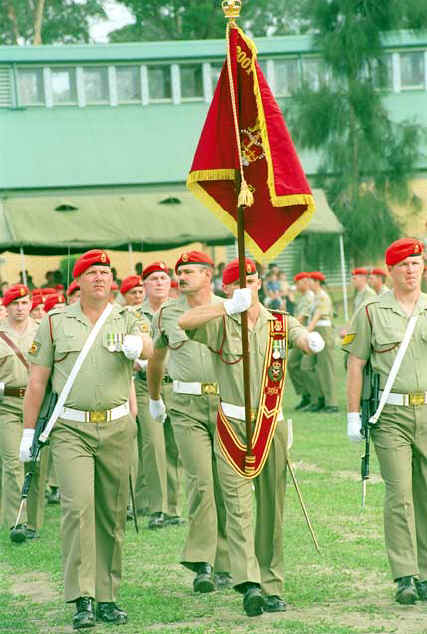 |
|
|||
 |
Parade for presentation of the Governor General's Banner to the Royal Australian Corps of Military Police RACMP in April 2001 at Army Military Police Training Centre (AMPTC)
|
| King's, Queen's, Royal or Governor General's BANNERS | |
There are currently three
types of banners within the Australian Army:
Banners are treated in a way very
similar to Colours. They are accorded high respect and compliment, and
they are treated with similar care, and duly saluted whilst being
paraded. |
|
The Princess Anne Banner |
|
|
On
10 September 1980, approval was given by Her Royal Highness, Princess
Anne, The Princess Royal, LG, GCVO, the RASigs Colonel-in-Chief, for the
Corps to carry a banner bearing her Cipher. The banner is known as
"The Princess Anne Banner"
Note the Cypher , a stylised "A" on what would be the top left hand corner were the flag flying. |
| The banner and its accoutrements consist of the following: - the banner, an English Bely, tassel, crown, pike, two SLR rifles, two chromed bayonets, two scabbards, two swords, and two white leather belts. |
In Australia, Colours are carried by the Royal Military College, Duntroon, Infantry Battalions and University Regiments. Banners are carried by those Corps or Units that have had them presented by Royal or vice-regal personages. The custom of presenting Banners to Australian Army units started with the presentation of twenty King’s Banners in 1904 for service in the Boer War. The Banners were presented by King Edward VII to eighteen Light Horse regiments, the Royal Australian Artillery, and the Australian Army Medical Corps; a further twenty-three of these Banners were presented to infantry units in 1911. It was stipulated that the Banners presented to the non-infantry units were not ‘King’s Colours’ but, ‘...Honourable Insignia presented (by King Edward VII) as a special mark of favour in recognition of valuable services rendered in South Africa during the 1899-1902 war, and that Honorary Distinctions are not to be borne on the Banners’. There are currently three types of Banners within the Australian Army. They are the Sovereign’s Banner which may be presented to any corps or unit including those with Colours by Her Majesty The Queen; Banners presented by other members of the Royal Family (these may be presented to any corps which does not have an entitlement to Standards, Guidons, or Colours); and the Governor-General’s Banner for training establishments which do not possess a Colour. Banners are accorded the same respect and compliments as the Queen’s Colours. On 10 September 1980, approval was given by Her Royal Highness, Princess Anne, The Princess Royal, LG, GCVO, the RASigs Colonel-in-Chief, for the Corps to carry a banner bearing her Cipher. The banner is known as "The Princess Anne Banner" The banner was presented at a parade at Simpson Barracks on 29 November 1986, on behalf of Her Royal Highness by His Excellency The Governor General, The Right Honourable Sir Ninian Stephen, AK, GCMG, GCVO, KBE.
The Commanding Officer, Army School of Signals, is the custodian of the banner and is responsible for its security and maintenance. The banner is permanently displayed in the foyer of the Army School of Signals when not being paraded on ceremonial occasions. |
 |
|
An unofficial Artillery banner of unknown origin |
|
|
| Australian Army Band Corps banner |
|
Unofficial "Welcome Home" banner from 1945/6 |
|
 |
 |
|
ANZAC Day Banners |
|
|
| This banner is the Anzac Day marching banner of the 4th, 12th & 13th Field Ambulances which made up the Australian Medical Corps (AMC) section of the 4th Division AIF in WW1. |





